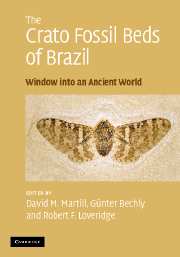Book contents
- Frontmatter
- Contents
- Contributors
- Preface
- Acknowledgements
- Part I The Crato Formation Konservat Lagerstätte
- Part II The invertebrate fauna
- Part III The vertebrate fauna
- 12 The Crato Formation fish fauna
- 13 Anurans of the Crato Formation
- 14 Turtles of the Crato Formation
- 15 Lizards of the Crato Formation
- 16 Crocodilians of the Crato Formation: evidence for enigmatic species
- 17 Pterosaurs of the Crato Formation
- 18 Birds of the Crato Formation
- Part IV The flora
- Part V Miscellanea
- Appendix: species list for the Crato Formation
- Systematic index
- Plate section
- References
12 - The Crato Formation fish fauna
Published online by Cambridge University Press: 22 August 2009
- Frontmatter
- Contents
- Contributors
- Preface
- Acknowledgements
- Part I The Crato Formation Konservat Lagerstätte
- Part II The invertebrate fauna
- Part III The vertebrate fauna
- 12 The Crato Formation fish fauna
- 13 Anurans of the Crato Formation
- 14 Turtles of the Crato Formation
- 15 Lizards of the Crato Formation
- 16 Crocodilians of the Crato Formation: evidence for enigmatic species
- 17 Pterosaurs of the Crato Formation
- 18 Birds of the Crato Formation
- Part IV The flora
- Part V Miscellanea
- Appendix: species list for the Crato Formation
- Systematic index
- Plate section
- References
Summary
Introduction
Fossil fishes are abundant in the Nova Olinda Member of the Crato Formation, where the ichthyofauna is dominated by the gonorynchiform Dastilbe crandalli (Figures 12.1b, 12.3c, 12.4a–12.4e). Fishes also occur, but more rarely, in the transition beds beneath the Nova Olinda Member at Cascata. Other fish taxa include the ophiopsid Placidichthys bidorsalis, the ichthyodectiform Cladocyclus gardneri, an undescribed amiiform, and rare occurrences of the semionotiform cf. Araripelepidotes sp. and the coelacanth Axelrodichthys sp. Except for Dastilbe and the amiiform, all the taxa cited above are well known and considerably more abundant in the slightly younger Romualdo Member of the Santana Formation of the same basin.
Recent collecting has yielded the semionotiform Lepidotes sp., a single specimen of the aspidorhynchiform Vinctifer longirostris and rare specimens of the tiny ostariophysan Santanichthys sp.
Many of the fishes occur as fully articulated skeletons with scales intact, and occasionally with in situ stomach contents. Partially articulated portions of fishes occur and may represent the relics of prey items, or portions from partially decomposed individuals. Isolated bones and scales also occur. Fishes are most frequently found preserved in left or right lateral view, with examples only rarely occurring in dorsal or ventral aspect. Bedding planes may contain several individuals of the same size (usually juveniles), suggestive of mass-mortality assemblages.
- Type
- Chapter
- Information
- The Crato Fossil Beds of BrazilWindow into an Ancient World, pp. 429 - 443Publisher: Cambridge University PressPrint publication year: 2007
References
- 7
- Cited by



